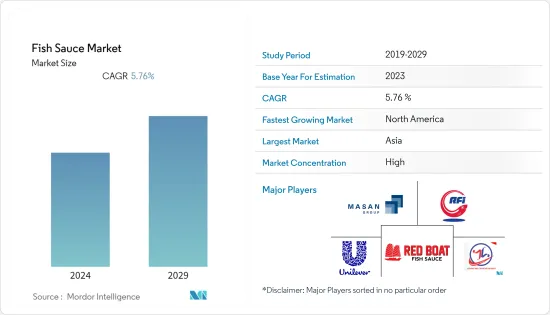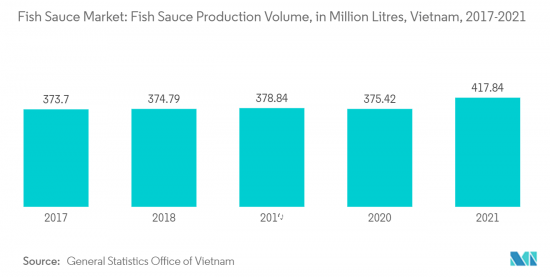
|
市場調査レポート
商品コード
1403111
魚醤:市場シェア分析、産業動向・統計、2024~2029年の成長予測Fish Sauce - Market Share Analysis, Industry Trends & Statistics, Growth Forecasts 2024 - 2029 |
||||||
カスタマイズ可能
適宜更新あり
|
|||||||
| 魚醤:市場シェア分析、産業動向・統計、2024~2029年の成長予測 |
|
出版日: 2024年01月04日
発行: Mordor Intelligence
ページ情報: 英文 120 Pages
納期: 2~3営業日
|
全表示
- 概要
- 目次
魚醤の世界市場は今年度112億1,000万米ドルで、今後5年間のCAGRは5.76%と予測されています。

主なハイライト
- 魚醤は、多くのアジア諸国の料理文化において不可欠な調味料とされる、最も人気のある発酵魚製品です。特徴的な風味と香りを持つ好塩菌を使用して製造されます。豊富なアミノ酸、塩溶性のペプチド、ナトリウム、カルシウム、ビタミンB12などのビタミンやミネラルを含んでいます。そのため、魚醤の高い栄養価に対する意識の高まりが世界市場の成長を後押ししています。
- さらに、栄養強化製品に対する需要の高まりが世界の魚醤市場を牽引しています。例えば、カンボジア政府は、国民の栄養安全保障を改善した成功戦略の1つとして、食品強化の重要性の高まりを認識しています。鉄強化魚醤のイントロダクションは、個人の健康状態の改善につながった。インドネシア、中国、タイなど多くのアジア諸国では、鉄分を強化した工業用魚醤を生産しています。調味料は、ビタミンA、鉄、葉酸、亜鉛といった栄養素の生物学的利用可能性に応じて、食生活に微量栄養素を浸透させるのに適したソースです。フルサービス・レストラン、カフェ、パブ、ストリート・キオスク・ファストフード、100%宅配といった外食産業の拡大により、習慣的・個別的な食品提供における強化魚醤の消費がさらに増加しました。
- さらに、魚醤は一般的に東南アジア諸国から輸出されるため、流通チャネルが市場成長に重要な役割を果たしています。これらの製品を効果的に販売するには確立された流通チャネルが必要であるため、市場では伝統的な魚醤や工業用魚醤を製造する既存ブランド間の熾烈な競争を目の当たりにしています。
魚醤市場の動向
人口の大部分における栄養不足
- 魚醤は、魚や魚の内臓に由来する重要な栄養素やミネラルの潜在的供給源であり、製造時の発酵によって強化されます。これらの栄養素は、睡眠をサポートし、消化器系と代謝を高め、血中コレステロールを減らし、脳と心臓の機能を向上させるなど、健康上の利点と関連しています。そのため、近年、魚醤の需要が大幅に増加しているのは、世界的に人口の大部分における食事性栄養素欠乏症の蔓延が拡大しているためです。
- 世界保健機関(WHO)は、世界人口の30%に相当する20億人以上が微量栄養素欠乏症に苦しんでいると推定しています。しかし、妊娠中の女性、授乳中の女性、幼児は、微量栄養素の欠乏に対して最も脆弱なグループであり、主にビタミンとミネラルの必要性が相対的に高く、欠乏による有害な影響を受けやすいからです。
- その結果、南オーストラリア保健医療研究所(SAHMRI)とアデレード大学の研究者により、カンボジアの母親と赤ちゃんにより良い栄養を提供するためのソースとして魚醤を使用する努力がなされています。さらに、魚醤の栄養価を高めるため、鉄分やその他のミネラルの強化にも力を入れています。このような努力と取り組みにより、調査期間中、市場の見通しは明るいと予想されます。

アジア太平洋が最大の魚醤市場
- 魚醤はタイ、ベトナム、カンボジア、ミャンマー、インドネシアなどの東南アジア諸国で広く消費されています。例えば、国家統計局によると、ベトナムの一人当たりの魚醤・つけ汁の月平均消費量は0.3リットルです。さらに、タイ、ベトナム、シンガポールは魚醤のトップ輸出国であり、Red Boat Fish Sauce、Squid、Viet Phu Inc.などが市場で著名なブランドです。
- 魚醤は主に、マリネ、ディッピング・ソース、炒め物のレシピで味のバランスをとるために使用されます。魚醤は風味を向上させるだけでなく、栄養価が高いため健康にも良いです。そのため、健康志向の高まりが市場の成長を後押ししています。これとは別に、この地域全体のシーフード嗜好が魚醤の需要をエスカレートさせています。タイ漁業省によると、2021年には約160万トンの魚製品がタイに輸入されました。
- さらに、個人におけるグルテン不耐症の増加に伴い、グルテンフリー製品の需要が高まっています。各ブランドは、進化する動向に対応し、市場での地位を維持するために、顧客のニーズを活用しています。例えば、タイの魚醤会社Squid Brandは2023年に2つの新製品、Mala Spicy Fish SauceとTruffle Fish Sauceを発売しました。これらの製品はグルテン、人工着色料、保存料を使用していないです。
魚醤業界の概要
世界の魚醤市場は統合され、競争が激しく、複数の世界・プレーヤーが優位を占めています。Masan Consumer社、Thanh Hung社、Red Boat社、Unilever PLC社、Rayong Fish Sauce Industry社などが市場の大手企業です。拡張と戦略的合意は、世界市場での地位を維持するためにこれらのプレーヤーが採用したいくつかの重要な戦略です。さらに、製品の革新は、顧客ベースとブランドイメージを維持するためにプレーヤーにとって不可欠です。
その他の特典:
- エクセル形式の市場予測(ME)シート
- 3ヶ月間のアナリストサポート
目次
第1章 イントロダクション
- 調査の前提条件と市場定義
- 調査範囲
第2章 調査手法
第3章 エグゼクティブサマリー
第4章 市場力学
- 市場促進要因
- 人口の大部分における栄養不足
- 民族の多様性と多文化主義
- 市場抑制要因
- 魚醤の消費を制限する高い塩分含有量
- ポーターのファイブフォース分析
- 新規参入業者の脅威
- 買い手/消費者の交渉力
- 供給企業の交渉力
- 代替品の脅威
- 競争企業間の敵対関係の強さ
第5章 市場セグメンテーション
- 製品タイプ
- 産業
- 従来
- 構成
- マス
- プレミアム
- エンドユーザー
- 食品メーカー
- 小売
- フードサービス
- 地域
- 北米
- 米国
- カナダ
- メキシコ
- その他北米地域
- 欧州
- ドイツ
- 英国
- スペイン
- フランス
- イタリア
- ロシア
- その他欧州
- アジア太平洋
- 中国
- 日本
- インド
- オーストラリア
- その他アジア太平洋地域
- 南米
- ブラジル
- アルゼンチン
- その他南米
- 中東・アフリカ
- アラブ首長国連邦
- 南アフリカ
- その他中東とアフリカ
- 北米
第6章 競合情勢
- 最も採用されている戦略
- 市場シェア分析
- 企業プロファイル
- Viet Phu Inc.(Red Boat Fish Sauce)
- Thai Fishsauce Factory(Squid Brand)Co. Ltd
- Unilever PLC
- Masan Group
- Rayong Fish Sauce Industry Co. Ltd
- Rungroj Fish Sauce Co. Ltd
- Pichai Fish Sauce Co. Ltd
- Tang Sang Ha Co.
- Sozye
- Thanh Hung Co., Ltd
第7章 市場機会と今後の動向

The global fish sauce market was valued at USD 11.21 billion for the current year and is projected to register a CAGR of 5.76% over the next five years.
Key Highlights
- Fish sauce is the most popular fermented fish product regarded as an indispensable condiment in the culinary cultures of many Asian countries. It is produced using Halophilic bacteria with a characteristic flavor and aroma. It contains abundant amino acids, peptides in salt-soluble form, and vitamins and minerals, including sodium, calcium, and vitamin B12. Therefore, the rising awareness about the high nutritional value of fish sauce is propelling the global market growth.
- Additionally, the rise in demand for fortified products drives the global fish sauce market. For instance, the Government of Cambodia has recognized the growing importance of food fortification as one of the successful strategies that improved the nutritional security of its people. The introduction of iron-fortified fish sauce has resulted in the improvement of health status among individuals. Many Asian countries, such as Indonesia, China, and Thailand, produce industrial fish sauces fortified with iron. Seasonings are better sources to infuse micronutrients in dietary practices, according to the bioavailability of nutrients, such as vitamin A, iron, folic acid, and zinc. The expanding food services industry, such as full-service restaurants, cafe, pubs, street kiosk fast food, and 100% home delivery, further increased the consumption of fortified fish sauce in customary and personalized food offerings.
- Furthermore, the distribution channels play a crucial role in the market growth, as fish sauce is generally exported from Southeast Asian countries. As a well-established distribution channel is required to effectively sell these products, the market witness fierce competition among the existing brands manufacturing traditional and industrial fish sauce.
Fish Sauce Market Trends
Nutrient Deficiency Among a Large Section of the Population
- Fish sauce is a potential source of vital nutrients and minerals derived from fish and fish organs and enhanced by fermentation during its production. These nutrients are associated with health benefits, such as supporting sleep, boosting the digestive system and metabolism, reducing blood cholesterol, and improving brain and heart function. Therefore, there has been a significant rise in the demand for fish sauce in recent years due to the increasing prevalence of dietary nutrient deficiency among a large section of the population globally.
- The World Health Organization (WHO) estimates that over two billion people, representing 30% of the global population, suffer from micronutrient deficiency. However, pregnant women, lactating women, and young children are the most vulnerable groups to micronutrient deficiencies, mainly because they have a relatively greater need for vitamins and minerals and are more susceptible to the harmful consequences of deficiencies.
- As a result, efforts have been made by researchers from the South Australian Health and Medical Research Institute (SAHMRI) and the University of Adelaide to use fish sauce as a source for providing better nutrition for moms and babies in Cambodia. Moreover, players focus on fortifying fish sauce with iron and other minerals to increase the nutritional value of their products. Such efforts and initiatives are anticipated to create a positive outlook for the market during the study period.

Asia-Pacific is the Largest market for Fish Sauce
- Fish sauce is widely consumed in Southeast Asian countries, including Thailand, Vietnam, Cambodia, Myanmar, and Indonesia. For instance, per the National Office of Statistics, the average monthly consumption of fish and dipping sauce per capita in Vietnam is 0.3 liters. Moreover, Thailand, Vietnam, and Singapore are the top exporters of fish sauce, with Red Boat Fish Sauce, Squid, and Viet Phu Inc. being some of the prominent brands in the market.
- Fish sauce is predominately used to balance the taste in recipes for marinades, dipping sauces, and stir-fries. Besides improving flavor, fish sauce provides several health benefits due to its high nutritional content. Therefore, the rising health consciousness drives the market towards growth. Apart from this, the preference for seafood across the region has escalated the demand for fish sauce. According to the Department of Fisheries (Thailand), about 1.6 million tons of fish products were imported into Thailand in 2021.
- Furthermore, the demand for gluten-free products rises with increased cases of gluten intolerance among individuals. Brands are capitalizing on customers' needs to keep up with the evolving trends and uphold their market position. For instance, in 2023, Thai fish sauce firm Squid Brand launched two new products, Mala Spicy Fish Sauce and Truffle Fish Sauce. These products are free from gluten, artificial colors, and preservatives.
Fish Sauce Industry Overview
The global fish sauce market is consolidated and highly competitive, with the dominance of several global players. Masan Consumer, Thanh Hung Co., Ltd, Red Boat, Unilever PLC, and Rayong Fish Sauce Industry Co. Ltd are some of the leading players in the market. Expansions and strategic agreements are some crucial strategies adopted by these players to maintain their position in the global market. Additionally, innovations in products have been essential for the players to retain their customer base and brand image.
Additional Benefits:
- The market estimate (ME) sheet in Excel format
- 3 months of analyst support
TABLE OF CONTENTS
1 INTRODUCTION
- 1.1 Study Assumptions and Market Definition
- 1.2 Scope of the Study
2 RESEARCH METHODOLOGY
3 EXECUTIVE SUMMARY
4 MARKET DYNAMICS
- 4.1 Market Drivers
- 4.1.1 Nutrient Deficiency Among a Large Section of the Population
- 4.1.2 Ethnic Diversity and Multiculturalism
- 4.2 Market Restraints
- 4.2.1 High Salt Content Limiting the Consumption of Fish Sauce
- 4.3 Porter's Five Forces Analysis
- 4.3.1 Threat of New Entrants
- 4.3.2 Bargaining Power of Buyers/Consumers
- 4.3.3 Bargaining Power of Suppliers
- 4.3.4 Threat of Substitute Products
- 4.3.5 Intensity of Competitive Rivalry
5 MARKET SEGMENTATION
- 5.1 Product Type
- 5.1.1 Industrial
- 5.1.2 Traditional
- 5.2 Composition
- 5.2.1 Mass
- 5.2.2 Premium
- 5.3 End-User
- 5.3.1 Food Manufacturers
- 5.3.2 Retail
- 5.3.3 Food Service
- 5.4 Geography
- 5.4.1 North America
- 5.4.1.1 United States
- 5.4.1.2 Canada
- 5.4.1.3 Mexico
- 5.4.1.4 Rest of North America
- 5.4.2 Europe
- 5.4.2.1 Germany
- 5.4.2.2 United Kingdom
- 5.4.2.3 Spain
- 5.4.2.4 France
- 5.4.2.5 Italy
- 5.4.2.6 Russia
- 5.4.2.7 Rest of Europe
- 5.4.3 Asia Pacific
- 5.4.3.1 China
- 5.4.3.2 Japan
- 5.4.3.3 India
- 5.4.3.4 Australia
- 5.4.3.5 Rest of Asia-Pacific
- 5.4.4 South America
- 5.4.4.1 Brazil
- 5.4.4.2 Argentina
- 5.4.4.3 Rest of South America
- 5.4.5 Middle-East and Africa
- 5.4.5.1 United Arab Emirates
- 5.4.5.2 South Africa
- 5.4.5.3 Rest of Middle-East and Africa
- 5.4.1 North America
6 COMPETITIVE LANDSCAPE
- 6.1 Most Adopted Strategies
- 6.2 Market Share Analysis
- 6.3 Company Profiles
- 6.3.1 Viet Phu Inc. (Red Boat Fish Sauce)
- 6.3.2 Thai Fishsauce Factory (Squid Brand) Co. Ltd
- 6.3.3 Unilever PLC
- 6.3.4 Masan Group
- 6.3.5 Rayong Fish Sauce Industry Co. Ltd
- 6.3.6 Rungroj Fish Sauce Co. Ltd
- 6.3.7 Pichai Fish Sauce Co. Ltd
- 6.3.8 Tang Sang Ha Co.
- 6.3.9 Sozye
- 6.3.10 Thanh Hung Co., Ltd


